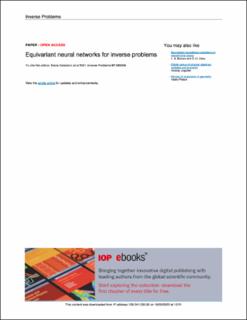| dc.contributor.author | Celledoni, Elena | |
| dc.contributor.author | Ehrhardt, Matthias J. | |
| dc.contributor.author | Etmann, Christian | |
| dc.contributor.author | Owren, Brynjulf | |
| dc.contributor.author | Schönlieb, Carola-Bibiane | |
| dc.contributor.author | Sherry, Ferdia | |
| dc.date.accessioned | 2022-10-26T08:28:41Z | |
| dc.date.available | 2022-10-26T08:28:41Z | |
| dc.date.created | 2021-08-11T16:24:45Z | |
| dc.date.issued | 2021 | |
| dc.identifier.citation | Inverse Problems. 2021, 37 (8), . | en_US |
| dc.identifier.issn | 0266-5611 | |
| dc.identifier.uri | https://hdl.handle.net/11250/3028341 | |
| dc.description.abstract | In recent years the use of convolutional layers to encode an inductive bias (translational equivariance) in neural networks has proven to be a very fruitful idea. The successes of this approach have motivated a line of research into incorporating other symmetries into deep learning methods, in the form of group equivariant convolutional neural networks. Much of this work has been focused on roto-translational symmetry of Rd, but other examples are the scaling symmetry of Rd and rotational symmetry of the sphere. In this work, we demonstrate that group equivariant convolutional operations can naturally be incorporated into learned reconstruction methods for inverse problems that are motivated by the variational regularisation approach. Indeed, if the regularisation functional is invariant under a group symmetry, the corresponding proximal operator will satisfy an equivariance property with respect to the same group symmetry. As a result of this observation, we design learned iterative methods in which the proximal operators are modelled as group equivariant convolutional neural networks. We use roto-translationally equivariant operations in the proposed methodology and apply it to the problems of low-dose computerised tomography reconstruction and subsampled magnetic resonance imaging reconstruction. The proposed methodology is demonstrated to improve the reconstruction quality of a learned reconstruction method with a little extra computational cost at training time but without any extra cost at test time. | en_US |
| dc.language.iso | eng | en_US |
| dc.publisher | IOP Publishing | en_US |
| dc.relation.uri | https://iopscience.iop.org/article/10.1088/1361-6420/ac104f | |
| dc.rights | Navngivelse 4.0 Internasjonal | * |
| dc.rights.uri | http://creativecommons.org/licenses/by/4.0/deed.no | * |
| dc.title | Equivariant neural networks for inverse problems | en_US |
| dc.type | Peer reviewed | en_US |
| dc.type | Journal article | en_US |
| dc.description.version | publishedVersion | en_US |
| dc.source.pagenumber | 27 | en_US |
| dc.source.volume | 37 | en_US |
| dc.source.journal | Inverse Problems | en_US |
| dc.source.issue | 8 | en_US |
| dc.identifier.doi | 10.1088/1361-6420/ac104f | |
| dc.identifier.cristin | 1925411 | |
| dc.relation.project | EC/H2020/691070 | en_US |
| cristin.ispublished | true | |
| cristin.fulltext | original | |
| cristin.qualitycode | 2 | |

